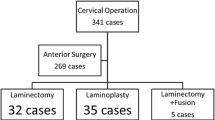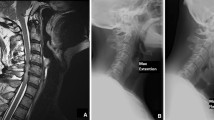Abstract
Axial pain is one of the major complications after laminoplasty, and preservation of C7 spinous process during the procedure can reduce the axial pain. However, it has not been elucidated whether laminoplasty preserving the C7 spinous process can maintain neurological improvement for a long time. The purpose of our retrospective study was to investigate the long-term neurological outcome after open-door laminoplasty preserving the C7 spinous process for cervical spondylotic myelopathy (CSM). Clinical and radiological outcomes were analysed in 42 patients who underwent open-door laminoplasty preserving C7 spinous process and followed up for more than 5 years. Neurological function was evaluated by means of the Japanese Orthopaedic Association (JOA) scoring system for cervical myelopathy. Axial pain was assessed using a visual analog scale (VAS) at the last examination. Alignment and motion of the cervical spine were measured from radiographs, and magnetic resonance imaging (MRI) was used to evaluate postoperative compression at C7. The mean JOA score was 9.4 before surgery and 12.0 at the latest follow-up. The mean VAS score in 26 patients score was 9.7/100. No compression of the spinal cord was observed in any MRI at the latest follow-up. Preservation of the C7 spinous process does not influence the long-term outcome of CSM after laminoplasty. Although we did not have a comparative group, the procedure described here should be considered as the solution.
Résumé
Analyse rétrospective sur le devenir neurologique des patients traités par laminoplastie pour les myélopathies cervicales. Les douleurs rachidiennes axiales sont une des complications majeures après laminoplastie. La préservation del’épineuse de C7, durant l’intervention peut faire en sorte de diminuer ces douleurs axiales. Cependant, il n’est pas facile de savoir pourquoi la préservation de l’épineuse de C7 peut maintenir un résultat neurologique à long terme. Le propos de cette étude est d’analyser à long terme le devenir des laminoplasties préservant l’épineuse de C7 lors des CSM. Les paramètres cliniques et radiologiques ont été analysés chez 42 patients qui ont bénéficié d’une laminoplastie préservant l’épineuse de C7, ces patients ont été suivis pendant 5 ans. L’analyse neurologique a utilisé le score de l’Association Japonaise d’Orthopédie (JOA), les douleurs rachidiennes axiales ont été analysées par une échelle analogique de la douleur (VAS) lors du dernier examen. L’alignement et la mobilité de la colonne cervicale ont été mesurés sur les radiographies et l’IRM a évalué les compressions post-opératoires au niveau de C7. Le score moyen JOA était de 9,4 avant la chirurgie et de 12 au dernier suivi. Le score moyen de la douleur (VAS), sur 27 patients, a été de 9,7 sur 100. Aucune compression de le moelle n’a été observée sur l’IRM lors du dernier suivi. La préservation de l’épineuse de C7 n’entraîne donc pas d’influence sur le devenir à long terme de la CSM après laminoplastie.Cependant, nous n’avons pas de groupes comparatifs dans le cadre d’une procédure prospective pour considérer si cette solution est parfaitement satisfaisante.




Similar content being viewed by others
References
Wada E et al (2001) Subtotal corpectomy versus laminoplasty for multilevel cervical spondylotic myelopathy: a long-term follow-up study over 10 years. Spine 26:1443–1447, discussion 1448
Wang MY, Green BA (2004) Open-door cervical expansile laminoplasty. Neurosurgery 54:119–123, discussion 123–124
Hosono N, Yonenobu K, Ono K (1996) Neck and shoulder pain after laminoplasty. A noticeable complication. Spine 21:1969–1973
Kawaguchi Y, Matsui H, Ishihara H, Gejo R, Yoshino O (1999) Axial symptoms after en bloc cervical laminoplasty. J Spinal Disord 12:392–395
Yoshida M et al (2002) Does reconstruction of posterior ligamentous complex with extensor musculature decrease axial symptoms after cervical laminoplasty? Spine 27:1414–1418
Katoh S, Ikata T, Hirai N, Okada Y, Nakauchi K (1995) Influence of minor trauma to the neck on the neurological outcome in patients with ossification of the posterior longitudinal ligament (OPLL) of the cervical spine. Paraplegia 33:330–333
Okada Y, Ikata T, Katoh S, Yamada H (1994) Morphologic analysis of the cervical spinal cord, dural tube, and spinal canal by magnetic resonance imaging in normal adults and patients with cervical spondylotic myelopathy. Spine 19:2331–2335
Wang MY, Shah S, Green BA (2004) Clinical outcomes following cervical laminoplasty for 204 patients with cervical spondylotic myelopathy. Surg Neurol 62:487–492
Fukui K, Kataoka O, Sho T, Sumi M (1990) Pathomechanism, pathogenesis, and results of treatment in cervical spondylotic myelopathy caused by dynamic canal stenosis. Spine 15:1148–1152
Suda K et al (2003) Local kyphosis reduces surgical outcomes of expansive open-door laminoplasty for cervical spondylotic myelopathy. Spine 28:1258–1262
Kawakami M, Tamaki T, Ando M, Yamada H, Yoshida M (2002) Relationships between sagittal alignment of the cervical spine and morphology of the spinal cord and clinical outcomes in patients with cervical spondylotic myelopathy treated with expansive laminoplasty. J Spinal Disord Tech 15:391–397
Author information
Authors and Affiliations
Corresponding author
Rights and permissions
About this article
Cite this article
Higashino, K., Katoh, S., Sairyo, K. et al. Preservation of C7 spinous process does not influence the long-term outcome after laminoplasty for cervical spondylotic myelopathy. International Orthopaedics (SICOT) 30, 362–365 (2006). https://doi.org/10.1007/s00264-005-0062-y
Received:
Accepted:
Published:
Issue Date:
DOI: https://doi.org/10.1007/s00264-005-0062-y




